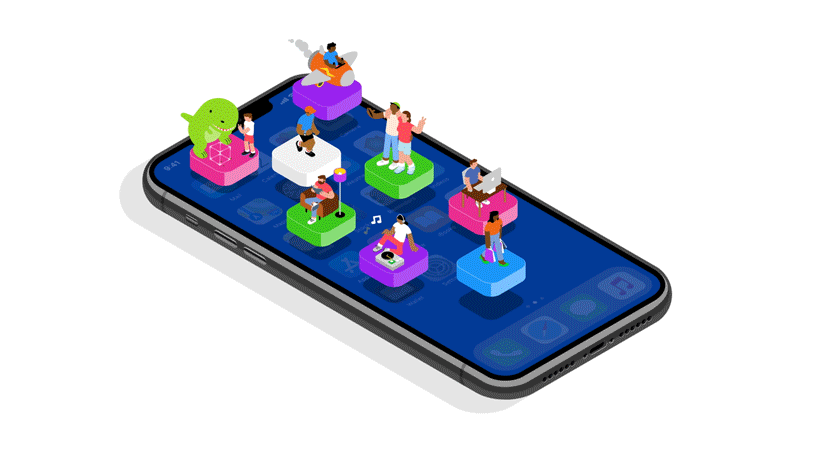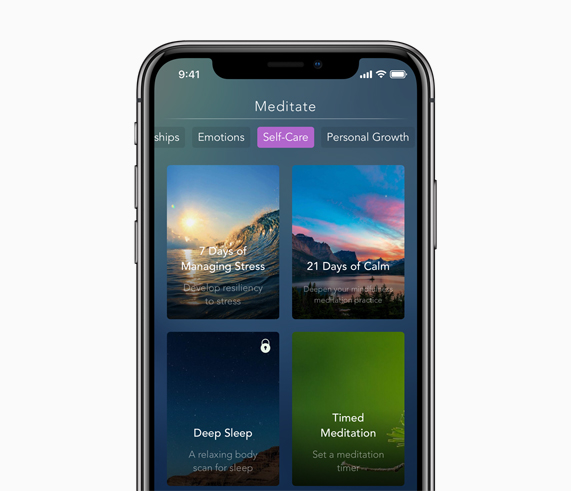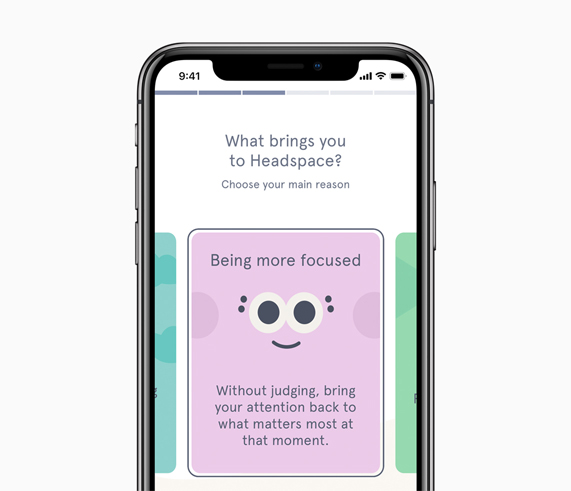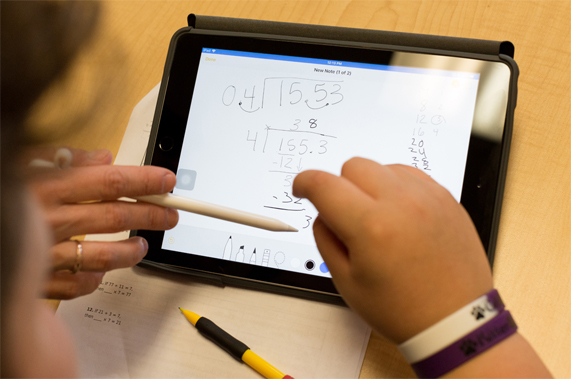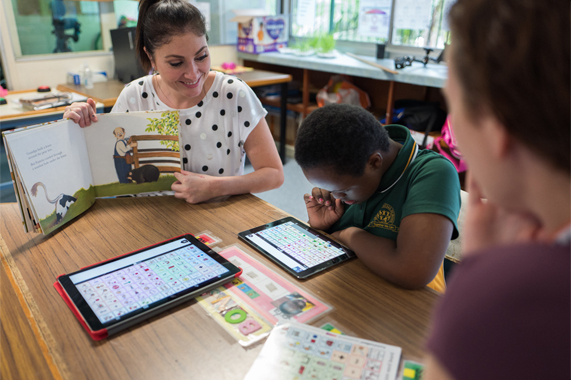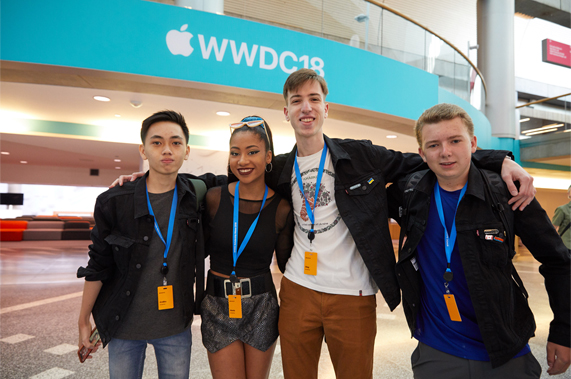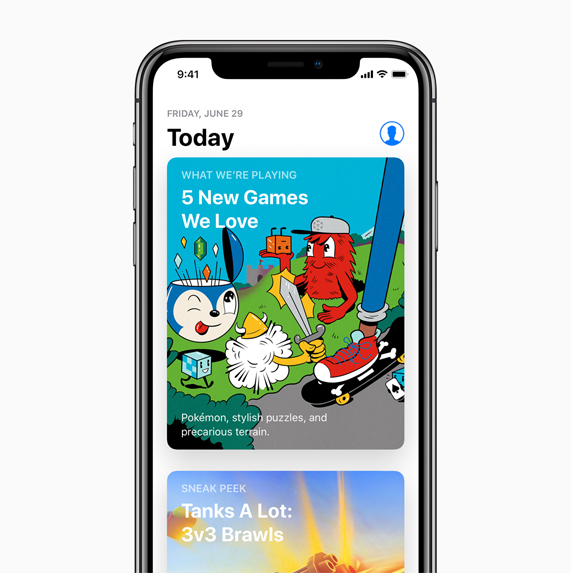FEATURE
July 5, 2018
The App Store turns 10
How Creativity, Innovation and Entrepreneurship Ignited a Worldwide App Phenomenon
When Apple introduced the App Store on July 10, 2008 with 500 apps, it ignited a cultural, social and economic phenomenon that changed how people work, play, meet, travel and so much more. Over the past decade, the App Store has created a safe place for users of all ages to get the very best apps and a vibrant app economy for developers of all sizes, from all over the world, to thrive. Today, customers in 155 countries are visiting the App Store more often, staying longer and downloading and using more apps than ever before.
While there have been many notable moments since apps first came to iPhone and later iPad, the milestones and testimonials below reflect some of the most significant over the past 10 years — defining how the App Store democratised software distribution and transformed how we live every day.
I. The App Store Opens Doors for Developers, Puts an All New Experience in the Hands of Customers
The App Store provides a groundbreaking solution for developers to distribute their software and consumers to experience apps like never before.
Phil Schiller, senior vice president, Worldwide Marketing, Apple: “In its first decade, the App Store has surpassed all of our wildest expectations — from the innovative apps that developers have dreamed up, to the way customers have made apps part of their daily lives — and this is just the beginning. We could not be more proud of what developers have created and what the next 10 years have in store.”
Marco Arment, developer of Overcast and longtime iOS developer: “Since day one, the App Store has been by far the easiest way for developers to reach the most people with our apps. It eliminated the friction and overhead of setting up our own distribution and payment systems, making development far more accessible to everyone and letting us focus on our true passion: making the best apps we can. Over its 10 years so far, the App Store has developed into the richest, most diverse, and most accessible software ecosystem the world has ever seen.”
Chad Evans, senior vice president, Product Development, Major League Baseball: “There was an incredible sense of anticipation and excitement the day the App Store launched, and getting to see MLB At Bat listed among the first 500 apps, but we don’t think anyone realised then the immense impact these apps would have on the ways fans experience sports. We feel fortunate to be part of the historic growth of the App Store these last 10 years. It’s exciting to think what opportunities the next 10 will bring as we continue working with Apple to connect fans more closely to their favourite teams and the game of baseball.”
Before 2008, the software industry was dominated by a few large companies. The App Store opened the door for any developer, from one-person shops to large studios, to come up with a great idea, build a high quality app and seamlessly deliver it to the growing number of customers around the world.
MLB At Bat, Tap Tap Revenge, Trism, The New York Times, eBay and Travelocity represented the wide range of apps available from day one, bringing to life an entirely new way to travel, play games, read the news and experience sports right in the palm of your hand.
Protecting user privacy is paramount in the Apple ecosystem, so from the beginning, Apple has taken great care in providing clear guidelines to developers and thoughtfully curating a safe, trusted app marketplace to ensure the best experience possible for customers around the world to discover and access apps.
II. Mobile-First Businesses Thrive
Keith Shepherd and Natalia Luckyanova, founders of Imangi Studios, creators of Temple Run: “The App Store and iPhone changed our lives. Our first game, Imangi, launched the day the App Store opened. Fast forward 10 years, and we’ve created over 10 games, including Temple Run, which has been downloaded over a BILLION times. Our studio has grown from the two of us to a team of 35. None of this would have been possible without the App Store.”
The cutting-edge hardware and quickly evolving software from Apple, combined with creative ideas from developers who saw the potential of iPhone being in customers’ pockets, spawned new industries that would forever change how people live, work and play — a revolution that continues today.
Start-ups including Instagram, Calm, Uber and Instacart embraced features like the iPhone camera, Apple Pay, GPS and Location Services to deliver on-demand and personalised experiences, with many creating billion dollar businesses that started with apps in the App Store. At the same time, both traditional companies and those that started as websites, such as Twitter, Facebook, eBay, Yelp, Airbnb and Amazon, began building apps to meet changing customer behaviour.
As a result, apps have become one of the most important ways that customers interact with businesses and tackle everyday tasks — whether it is to book a flight or hotel room, make a dinner reservation, shop for gifts or pay bills.
III. Gaming Takes Off, Reaches New Fans
Shigeru Miyamoto, representative director and fellow, Nintendo: “We are very happy that we are able to deliver Super Mario Run, a new Super Mario experience that could be played with just one hand on iPhone, to hundreds of millions of consumers because of the App Store. The App Store allows us to share the joy of Nintendo games with many new audiences, and we will continue striving to provide unique and new game experiences to App Store customers.”
Riccardo Zacconi, CEO of King, creators of Candy Crush: “We launched Candy Crush Saga on the App Store over five years ago and it’s been hugely beneficial, allowing us to reach a brand new global audience. Our games have been played in all seven continents, including Antarctica! That shows just how influential and far-reaching the App Store has become.”
Daniel Wu, president of Hero Entertainment, creators of Red Tides: “The App Store offers us the opportunity to bring great eSports experiences from desktop to mobile and let the game fans and players meet online to offline and thoroughly enjoy the charm of games and even establish new ways to socialise.”
The App Store brought gaming mainstream, thanks to the easy Multi-Touch technology on iPhone and iPad and the convenience of playing on the go. Customers were drawn to early titles like Super Monkey Ball, PAC-MAN, Angry Birds, Words With Friends, Real Racing and Temple Run, leading iOS to become the most popular gaming platform in the world.
Games such as Heads Up!, Pokémon Go, HQ and Fortnite have created communal, cultural moments around the world, while new technologies have brought console quality games to mobile, including Vainglory, The Witness and Arena of Valor.
IV. In-App Purchase, Subscriptions Unlock Experiences
Horace Dediu, analyst, Asymco: “The App Store completely changed the way people access and pay for software and services. Only through the power of a software ecosystem can subscriptions emerge and grow to such a level. The App Store created a means for others to become successful — many more than could possibly be imagined in ways that could not possibly be imagined — and freed people to be creative in unforeseen dimensions.”
With the introduction of in-app purchase (IAP) in 2009, customers could download an app and then pay to unlock different levels and functionality, allowing more people to experience new apps before committing to buying them. By June 2010, USD$1 billion would be paid out to developers from IAP and paid apps.
In 2011, the App Store started supporting subscription apps, and by 2016, had expanded support to all 25 of its categories, including Games, Kids and Health and Fitness. Over 28,000 iOS apps now offer subscriptions, including Netflix, iQiYi, Tinder, LinkedIn, Sing! By Smule, Headspace and Dropbox, making it easy for millions of new customers to instantly discover and sign up for or unsubscribe from these services. Subscriptions are up 95 percent from last year, and as of June 2018, developers have earned over USD$100 billion from the App Store.
V. Streaming Entertainment Takes Off

More customers are watching TV shows, movies and video on the go.
Richard Plepler, chairman and CEO, HBO: “When we decided to introduce HBO NOW, there was never a question that our exclusive launch partner had to be Apple. Announcing the streaming service with Apple and the arrival of HBO NOW on the App Store is one of the most significant moments in HBO’s storied history.”
The App Store has been the epicentre of a mobile video consumption boom. The larger screen sizes and resolution of iPhone and iPad have made customers more comfortable watching video on the go, while services including HBO NOW, Hulu, Netflix and Sling TV and the abundance of quality shows allow customers to enjoy the entertainment they love when and where they choose.
VI. Creativity, Productivity and Education Soar Beyond Office, Classroom Walls
James Cuda, founder and CEO of Savage Interactive, creators of Procreate: “From the beginning, we wanted to sell Procreate exclusively through the App Store because it allows us to reach customers everywhere, making it easy to provide new features, respond to feedback and ensure artists are getting the best possible experience. Being a part of the App Store’s journey has been life-changing, as millions of our customers are discovering digital art creation for the first time, while many industry-leading artists find Procreate with iPad Pro and Apple Pencil to be a powerful combination. Procreate simply would not be possible without the App Store.”
Yan Lin, CEO of Dr. Panda, developer of popular kids games: “Thanks to the incredible opportunities brought by the App Store, Dr. Panda has transformed from a small Chinese startup to a global kids brand loved by both children and parents with 50 million downloads around the world in only six years.”
In 2010, iPad introduced a giant canvas with new possibilities for customers to create and learn. Professionals around the world are choosing iPad Pro to explore new levels of creativity and productivity, thanks to its portability and versatility, and learners of all levels embrace iPad as a tool for work and play. Today, customers can enjoy more than 1.3 million apps designed specifically for iPad, including Procreate, Lightroom, Microsoft Office 365 and Prêt-à-Template — which allow for creativity on the go, beyond office or studio walls, or wherever inspiration may strike.
With over 200,000 educational and reference apps like Explain Everything and The Elements from Touch Press, iPad has helped nurture rich, engaging ways to learn, express creativity and encourage collaboration. Additionally, education apps such as Froggipedia, WWF Free Rivers and Boulevard AR have quickly embraced augmented reality (AR) to make the learning experience even more immersive for students.
VII. Health, Fitness and Wellness Apps Surge in Popularity
Tobi Pearce, CEO and founder of Sweat, a fitness app and community for women, and Kayla Itsines, co-creator of BBG Guide and Sweat Trainer: “The App Store provides Sweat the ability to reach and improve the lives of millions of people around the world through health and fitness, building a bigger community and offering flexibility in when, where and how users work out. Being a part of the Apple ecosystem has brought continued growth opportunities that have fundamentally changed the trajectory of our organisation.”
Francoise A. Marvel, MD, Corrie Health Team, Johns Hopkins, Cardiology: “Over the last 10 years, the App Store has contributed to the advancement of innovation in patient care by creating a platform for state-of-the-art medical apps like Corrie at Johns Hopkins. Our mobile health research relies on the App Store to deliver life-saving and life-changing apps to our patients.”
Apple Watch and HealthKit paved the way for developers to make health, fitness and wellness apps more innovative, intelligent and interactive, which in turn have inspired customers to be more active and mindful of their health. Downloads for these apps have increased 75 percent since the launch of Apple Watch, led by apps such as Zova, Nike, Lose It!, Dexcom, One Drop, Glow, 10% Happier and Yoga Glo.
More than 500 doctors and medical researchers have used Apple’s ResearchKit and CareKit software tools for clinical studies involving 3 million participants on conditions ranging from autism and Parkinson’s disease to post-surgical at-home rehabilitation and physical therapy. Thanks to these innovative tools, customers are increasingly able to use iOS and Apple Watch apps to monitor their overall health and well-being.
VIII. Accessibility Apps Empower Communities
Richard Ellenson, developer and CEO, Cerebral Palsy Foundation: “In the world of assistive technology and accessibility, it’s impossible to overstate the importance of the App Store. For individuals with disabilities, for professionals, family members, and anyone who’s ever wondered about the potential in another person who had a bit of difference — or deeply significant challenges — the App Store has been profoundly transformational. I have seen it unleash possibility and potential in literally thousands of individuals. Yet, closest to my heart, I have seen it do so for my son: a bright, independent 20 year old who has Cerebral Palsy. My son moves about in a wheelchair, but that is simply the place from which his spirit soars. His voice comes from his iPad, he does his homework on iPad, his social life is rooted in the apps on iPad, he navigates his entertainment on iPad, and he has performed a thrilling one-man-show with his iPad. I cannot imagine my son's life without this technological magic. And I know so many others for whom this is also true. It’s not a reach to say the App Store has been the single greatest advance for accessibility — ever.”
David Niemeijer, founder and CEO, AssistiveWare, creators of accessibility apps: “The App Store has made the world much more accessible, and made it easier for AssistiveWare to realise its vision of creating a world without communication barriers. Without it, AssistiveWare would likely still be a one-man Mac developer. Now we provide iOS communication apps to over 200,000 people worldwide, many of whom would not be able to communicate effectively without them.”
Since 2009, millions of customers have benefitted from apps such as Lyft, Twitter, Starbucks and TED that incorporate the rich accessibility features built into iOS including VoiceOver, while others like Voice Dream Reader and CP Channel have provided crucial support for communities with assistive needs. With accessibility features seamlessly woven in, these apps support more customers and lead to a more inclusive and engaging user experience.
IX. Coding Inspires Future Generations
Amanda Southworth, executive director of Astra Labs, creators of anxietyhelper and Verena: “Apple undoubtedly revolutionised the way developers and users connect. To this day, the App Store continues to innovate and it’s in a class of its own. With the work that I'm doing in the non-profit sector, it's important that the work we do can be easily found and distributed, and that's exactly what the App Store has done. It has created opportunities that I am thankful for every day, and I'm so glad that I'm a part of the community that calls the App Store our home.”
Masako Wakamiya, developer of hinadan, based on a traditional Japanese celebration known as Doll Festival: “After turning 82, I started thinking about making games that even seniors could enjoy. Friends taught me how to program and I created an app for iPhone. People often ask me, ‘What made you want to do that?’ Because older people tend to look backwards, I think it’s better to take the leap forward, jump to new things and enrich our lives. My app supports Japanese, English and Chinese, making it possible for me to connect with people around the world through this app. Just thinking about that makes me excited. It’s truly thanks to the App Store.”
Every year, Apple hosts thousands of software developers from all over the globe to talk about the latest developments in apps at the Worldwide Developers Conference (WWDC). Starting in 2013, Apple awarded scholarships to about 150 students to attend, and by 2018, that number had grown to over 350 talented students and STEM organisation members from 42 different countries. Scholarship winners receive a free ticket to the conference, along with lodging and a one-year Apple Developer Program membership. Past scholarship winners have started their own STEM non-profit organisations to encourage their peers to learn coding and created apps that are tackling issues such as mental health, safety and climate change.
Apple introduced the Everyone Can Code program in 2016 to encourage learning, writing and teaching code, and today it is available to tens of millions of students around the world who can learn code, problem solve and create apps that will transform the future. Also in 2016, Apple launched Swift Playgrounds, an innovative iPad app that brings real coding concepts to life with an interactive interface for students of all ages and beginners to explore working with Apple’s Swift coding language.
X. New App Store Features Encourage Discovery
Dan Gray, head of studio, ustwo Games, creators of Monument Valley: “We built our entire team around the App Store, and we’ve been able to have millions of people around the world play our games who never would have considered themselves gamers. The App Store refresh has shown players the creators behind the apps they enjoy everyday. Humanising apps can only be a good thing and showcasing how they’re made will inspire the next generation of creators from every corner of the world.”
In 2017, Apple unveiled an all-new App Store, creating a daily destination with dedicated Games and Apps tabs for customers to find exactly what they are looking for or be inspired to try something new, and learn about the creators behind the apps they know and love. The App Store now sees 500 million weekly visitors who are spending more time discovering new apps than ever before, and hundreds of stories on the Today tab have been read by more than 1 million people.
XI. The AR Revolution Awaits
John Hanke, CEO, Niantic: “When we founded Niantic, we set out to develop technology that would inspire people to explore their communities, exercise and have fun with friends and family out in the real world. In addition to making Pokémon GO and Ingress easily accessible to hundreds of millions around the world, the App Store has done a fantastic job of shining a spotlight on our player communities, thoughtfully crafting stories to inform and educate our players, and making the ongoing feature rollout easy for our development team.”
Augmented reality is a transformational technology that brings virtual experiences into the real world, changing the way customers both work and play. In 2017, Apple introduced ARKit 1.0 and overnight iOS became the biggest AR platform in the world, available to hundreds of millions of iPhone and iPad users. Today, over 3,000 AR apps on the App Store, such as King of Pool, Alice in Wonderland AR Quest and Houzz, creating an even more engaging way for customers to shop, learn and play games. Apple delivered the third ARKit update to developers at WWDC in June 2018, making it possible for AR apps like LEGO to include shared experiences that allow multiple users to play a game or collaborate on projects, as well as persistent AR experiences that make it possible to start a puzzle on a table and come back to it later.
With Core ML, apps get smarter by quickly and intelligently understanding images, video and text to deliver new and exciting experiences. Applying stylistic filters to photos with BeCasso, adding fun effects with Snapchat, and for those with low vision, easily navigating the world around them with Seeing AI are all examples of how Core ML is put to use — all while keeping data private.
Images of App Store Anniversary
